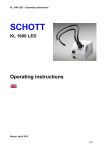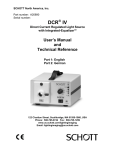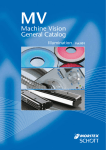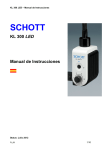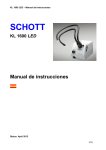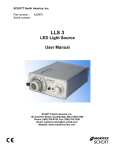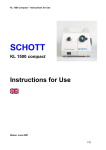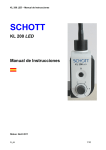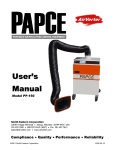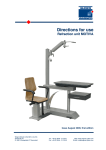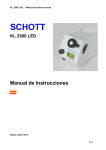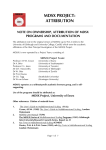Download User Manual KL 300 LED (english)
Transcript
KL 300 LED – Operating instructions SCHOTT KL 300 LED Operating instructions Status: July 2012 PI_69 1/10 KL 300 LED – Operating instructions Contents 1. Important information.............................................................…..............4 2. Operation.................................................................................................6 2.1 Assembly.................................................................................................6 2.2 Light guide connection................................….........................................6 2.3 Power connection....................................................................................7 2.4 Start-up procedure.......................................…........................................7 2.5 Light intensity setting…............................................…............................7 3. Maintenance..................................................….................…..................8 4. Troubleshooting............... .......................................................................8 5. Accessories.............................................…............................….....….....8 6. Technical data.......................…...............................................................9 PI_69 2/10 KL 300 LED – Operating instructions Instrument overview 4 6 1 PI_69 2 5 7 3 8 (1) Light guide socket 2.2 (2) Indicator light 2.4 (3) On/off switch 2.4 (4) Mains connection socket 2.3 (5) Attachment adapter socket (base of instrument) 2.1 (6) Heat sink (7) Electronic light intensity setting (8) Model plate (base of instrument) 2.5 3/10 KL 300 LED – Operating instructions 1. Important information Symbols used Symbol ! Meaning Warning of danger (caution, obey documentation) Mains supply on/off LED-radiation (caution, do not look directly into the beam!) Intended use The KL 300 LED cold light source is intended for industrial and laboratory applications. Cold light sources are used for the intensive illumination of all types of objects. High-intensity visible light is guided to the object using flexible or self-supporting, movable light guides. In accordance with the EN 62471:2008 standard the KL 300 LED is a product of Risk Class 2. The KL 300 LED fiber optic light source conforms to the following European directives: 2006/95/EC (Low Voltage Directive) 2004/108/EC (EMC Directive) 2002/95/EC (RoHS) The technical documentation and full compliance with the standards listed below proves the conformity of the illumination system with the essential requirements of the following EC Directives: EN 61010-1 :2001 EN 61326-1:2006 EN 55011:2009 EN 61000-3-2:2006 + A1:2009 + A2:2009 EN 61000-3-3:2008 ! Safety information: Please read and obey these instructions carefully. The instrument’s safety cannot be guaranteed if they are not obeyed. Do not look directly into the open light guide socket or the light guide exit when the light source is switched on (danger of ophthalmic injury)! PI_69 4/10 KL 300 LED – Operating instructions The KL 300 LED emits high-intensity visible light. Because light-absorbing materials have the physical property of converting incident light into heat, damage can arise to heat-sensitive or flammable light-absorbing materials. To avoid such thermal damage and the potential danger of fire or burns, please obey the following instructions: • Never cover up the light guide socket or light guide exit (danger of fire)! • Never cover up the open light guide socket or light guide exit with your hands or other parts of the body (danger of burns)! • When illuminating heat-sensitive or flammable light-absorbing objects (e.g. in microscopy), special care must be taken to ensure that an appropriate suitable distance between light guide and object, and a suitable lamp brightness level are selected so that no thermal damage occurs. • When the light source is switched on, all light guide exists not being used in the working procedure must always be a safe distance – at least 10 cm – away from heat-sensitive or flammable light-absorbing materials (prevention of possible danger of fire). Care must, therefore, be taken that each light guide exit is at the above-mentioned safe distance away from, for example, dark/colored textiles and dark/colored wooden or plastic surfaces. • To avoid unnecessary stressing of biological tissue by illuminating with visible light, reduce the brightness and duration of illumination to the absolute minimum required level. Please make sure that your KL 300 LED cold light source is operated at the voltage stated on the model plate (8). ♦ The light source has been developed for operation in dry rooms only! (see Point 6 “Technical Data”)! ♦ The instrument must not be used in explosive areas. ♦ Safe disconnection from the power supply occurs only by pulling out the mains plug. ♦ The instrument may neither be opened nor dismantled. Technical modifications are forbidden. Repairs must only be carried out by the manufacturer or by its authorized customer service agency. ♦ Please ensure that every user of the system has quick access to these operating instructions. ♦ The manufacturer is not liable for damage caused by failure to obey these instructions. PI_69 5/10 KL 300 LED – Operating instructions 2. Operation 2.1 Assembly A B KL 300 LED is designed for assembly directly on all conventional microscope objectives or swivel arm stands. Suitable adapters are either enclosed with the light source or are available from the manufacturer (see Point 5 “KL 300 LED accessories”). First insert the appropriate side of the attachment adapter (A) into the intended socket (5) on the base of the light source until stop. Then insert both fixing screws (M5) from below through the groove (B) and tighten using a 3-mm Allen key. The light source can now be clamped to the microscope objective or swivel arm stand with the attachment adapter. If necessary, the microscope or the microscope carrier must be taken off and re-assembled afterwards. Alternatively, when using flexible light guides, the KL 300 LED can be laid flat on the work surface without an attachment adapter. 2.2 Light guide connection The light guide is inserted into the light guide socket as far as the stop (1). To ensure a tight fit and optimum illumination the groove must click into the retaining slot. To remove, simply pull the light guide out of the light guide socket (1). Please note: When inserting light guides with a locating pin, care must be taken to ensure that the pin fits into one of the two guide slots. PI_69 6/10 KL 300 LED – Operating instructions 2.3 Power connection Insert the hollow plug of the supplied power cord into the plug-in socket (4) of the light source. Please take care to ensure that you only operate your KL 300 LED light source with the power cord provided. The plug connection of the power supply is interchangeable for the EU, UK, US or AU. This is connected to the mains supply (100-240 V AC, 50-60 Hz). 2.4 Start-up procedure Switch on/off the KL 300 LED by pressing the switch (3). When the instrument is switched on the blue control light (2) is lit. Please disconnect power by pulling out the power plug. 2.5 Light intensity setting The brightness can be adjusted continuously by turning the light intensity setting knob (7). Five-step intensity control is possible, from 0 – 5. The highest brightness is reached at the end stop at position 5. When the brightness control is set at 0 there is no more brightness, i.e. the lamp is off. Attention: Please note that when the brightness control is set at 0 the instrument is not switched off. When the instrument is switched on the blue control light (2) is lit. To switch off the KL 300 LED press the on/off switch (3) once (see point 2.4 “Start-up procedure”). Please ensure safe power disconnection by pulling out the power plug! PI_69 7/10 KL 300 LED – Operating instructions 3. Maintenance Your KL 300 LED is maintenance-free. The light source should not be disinfected for used in medical applications. To clean the outside of the instrument please use a soft dry cloth or commercially available plastic cleaning cloths. 4. Troubleshooting Should you be unable to rectify the faults by the measures listed below, please contact your specialist dealer or the nearest SCHOTT agency. More extensive repairs must be carried out by an authorized after sales service. Fault Possible cause Remedial action Lamp out Instrument not switched on Switch instrument on Plug not in socket Plug in socket No mains electricity voltage Check mains voltage Electronics overheated Switch off instrument. Ensure adequate cooling, switch on again after prolonged cooling time. Light intensity dropping 5. KL 300 LED accessories A wide range of accessories is available for your KL 300 LED. Please see our separate catalogue for further details (contact address for additional requirements can be found on page 10). Proper functioning, safety and optimum luminous efficiency can only be guaranteed with SCHOTT light guides and accessories. Self-supporting and flexible light guides are available in various lengths and diameters, as well as spot illuminations. Optical filters can be used as screw-in or clip-on filters in conjunction with a focusing attachment (accessory) in front of the light guide exit. Details on the focusing attachment and available standard filter types can be found in our catalogue. PI_69 8/10 KL 300 LED – Operating instructions Adapters for attaching the KL 300 LED to microscope objectives and swivel arm stands are available, either with this light source or they can be ordered separately. Please see our catalogue for further details on each type. The light source can also be used as a “stand-alone” instrument if the light source is not mounted on an objective or a swivel arm. When using flexible light guides no accessories are required (see Point 2.1 “Assembly”). A base with a corresponding fixing devise is available for use with selfsupporting light guides. Please also refer to our catalogue for more information. 6. Technical data for KL 300 LED Properties Values General information Type description KL 300 LED Dimensions (W x D x H) mm approx. 107 x 114 x 61 Weight kg approx. 0.35 Cooling Convection Ambient temperature* °C + 5 ... + 40 Relative air humidity* % at 31°C ambient temperature: 80% From 31°C to 40°C ambient temperature: decreasing linearly to 50% Air pressure* hPa 700 ... 1060 Transport and storage Temperature Rel. air humidity Air pressure °C % hPa -20 ... +70 10 ... 95 (non-condensing) 500 ... 1200 Contamination level 2 Electrical information Operating voltage, frequency Power consumption, max. 100 - 240 V ~ 50 - 60 Hz VA max. 5 Protection class II Overvoltage category II Diode LED, Luxeon Rebel LED nominal output W 3 Average LED lifetime LED Level 5 h 50,000 (luminous flux reduced to 70%) * Test conditions of DIN EN 61010-1 and UL61010-1 standards PI_69 9/10 KL 300 LED – Operating instructions Lighting information Maximum effective light guide bundle diameter mm 6 Total light flux at light guide exit (SCHOTT light guide Ø 4.5 mm, typical values) Level 5 lm 80 Color temperature K Approx. 5,600 Light exit angle (2α eff ) Approx. 53° Conformity CE (power supply CE, UL, PSE) B EMC emission class We reserve the right to make changes in the design and supplied items within the scope of ongoing technical improvements. WEEE declaration Your SCHOTT product was produced and developed with high quality materials and components. The symbol indicates that electrical and electronic devices must be separated from domestic waste and appropriately disposed of after useful life. SCHOTT AG Lighting and Imaging has arranged a waste management system for recycling. Please use this system for removal and help to protect the environment we live in. Further information regarding our waste management system, please refer to www.schott.com/lightingimaging/recycle SCHOTT AG Business Unit Lighting and Imaging Otto-Schott-Strasse 2 55127 Mainz GERMANY Tel. + 49 / 6131 / 66 - 0 PI_69 10/10










